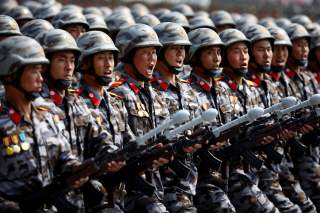North Korea's Greatest Wish: How the U.S.–South Korea Alliance Could Die
It is easy to imagine how the two nationalist presidents could butt heads.
With North Korea rapidly expanding its nuclear and missile capabilities, maintaining a robust U.S.–South Korean alliance is vital. Unfortunately, there is a ticking time-bomb that threatens to throw the alliance in a tailspin.
This time-bomb is the upcoming renegotiation of the burden sharing agreement known as the Special Measures Agreement (SMA). The current five-year SMA, negotiated in 2014, will expire in 2018, meaning negotiations will need to begin soon. Financial matters between allies can always be touchy, and the combination of Donald Trump’s “America First” foreign policy and Moon Jae-in’s Korean nationalism could make this round particularly toxic. If handled correctly, however, Trump and Moon can revitalize the alliance and put it on a more sustainable footing for years to come.
Under the current SMA, South Korea covers approximately 50 percent of nonpersonnel costs (about $821 million in 2016) and contributes $9 billion towards the relocation of U.S. bases in South Korea. Negotiations of the 2014 agreement were tense, with anti-American protests and some South Korean lawmakers calling the talks “humiliating.” During the process, Seoul’s primary concern was a lack of transparency and control over how South Korean contributions were used. These concerns were addressed in the 2014 SMA by requiring the United States to report to the Republic of Korea (ROK) on how the funds are used. Nonetheless, they are certain to reappear in the new negotiations, especially with Moon’s party now in control.
Recommended:
Why North Korea's Air Force is Total Junk
Why Doesn't America Kill Kim Jong Un?
The F-22 Is Getting a New Job: Sniper
For the United States, the biggest concern is getting Seoul to contribute more to its own defense. This concern long predated the current U.S. administration, but it will be especially important to President Trump. As a presidential candidate, Trump went so far as to suggest that if Seoul did not cover “100 percent” of alliance costs the United States should be “prepared to walk,” leaving South Koreans to “defend themselves.” As president, Trump has made increased alliance contributions a cornerstone of his foreign policy, meaning he is unlikely to back down in SMA talks.
Interestingly, however, the U.S. president might find his South Korean counterpart to be an ideal partner. While Trump and Moon have widely divergent views on how to deal with the North Korean threat, both agree that South Korea should have more responsibility for its own defense. Despite widely being thought of as a dove, Moon is calling for a 7 percent increase in defense spending in 2018. He has also pushed the United States to loosen restrictions on South Korea’s missile capabilities and is seeking nuclear submarines.
Moon’s interest in strengthening South Korea’s military capabilities is part of his desire to regain wartime operational control (OPCON) over ROK forces. The United States first gained OPCON over ROK forces during the Korean War and has made the transfer of wartime OPCON conditional on increased South Korean military capabilities. President Moon and much of his South Korean left-wing base are Korean nationalists who consider OPCON a pressing sovereignty issue.
It is easy to imagine how the two nationalist presidents could butt heads in the upcoming burden sharing negotiation. President Trump is widely unpopular in South Korea and could easily make undiplomatic comments that could inflame latent ROK anti-Americanism. President Moon’s left-wing allies are already distrustful of the United States and will likely press him to drive a hard bargain. Perceptions of bad faith on either side flamed by public comments or protests in Seoul could easily poison alliance relations.
However, the combination of Trump and Moon offers some promising possibilities. President Moon’s push for more defense spending could help offset U.S. basing and personnel costs. This is entirely appropriate for a wealthy country like South Korea, especially when one considers that other countries, like Japan, pay a higher portion of U.S. alliance costs. One mutually beneficial way to increase burden sharing is to count a portion of U.S. arms sales to South Korea as part of Seoul’s contributions to the alliance. This would appeal to President Trump, who has touted increased arms exports as a way to bolster the American economy. Purchasing high-tech American military systems would be in line with President Moon’s desire to strengthen South Korea’s military and regain wartime OPCON.
At the same time, America’s willingness to sell South Korea more advanced weaponry and transfer wartime command to ROK forces must be not be unconditional. In particular, just as President Moon has said America cannot conduct military operations against North Korea without Seoul’s approval, the United States must retain a share of military decision-making as long as it has troops on the peninsula. That way, U.S. forces will not be dragged into a war by risky unilateral actions by South Korea, such as preventive or decapitation strikes on North Korea.
In sum, the governments in Seoul and Washington must ensure that the upcoming SMA negotiations don’t disrupt the alliance at a time when they must be laser-focused on dealing with the North Korean threat. Beyond that, however, they should look for opportunities to modernize the alliance to secure its longevity into the future.
Leon Whyte (@Leon_Whyte) is the Research Coordinator at the Nonproliferation Policy Education Center, where Zachary Keck (@ZacharyKeck) is the Wohlstetter Public Affairs Fellow.
Image: Reuters

